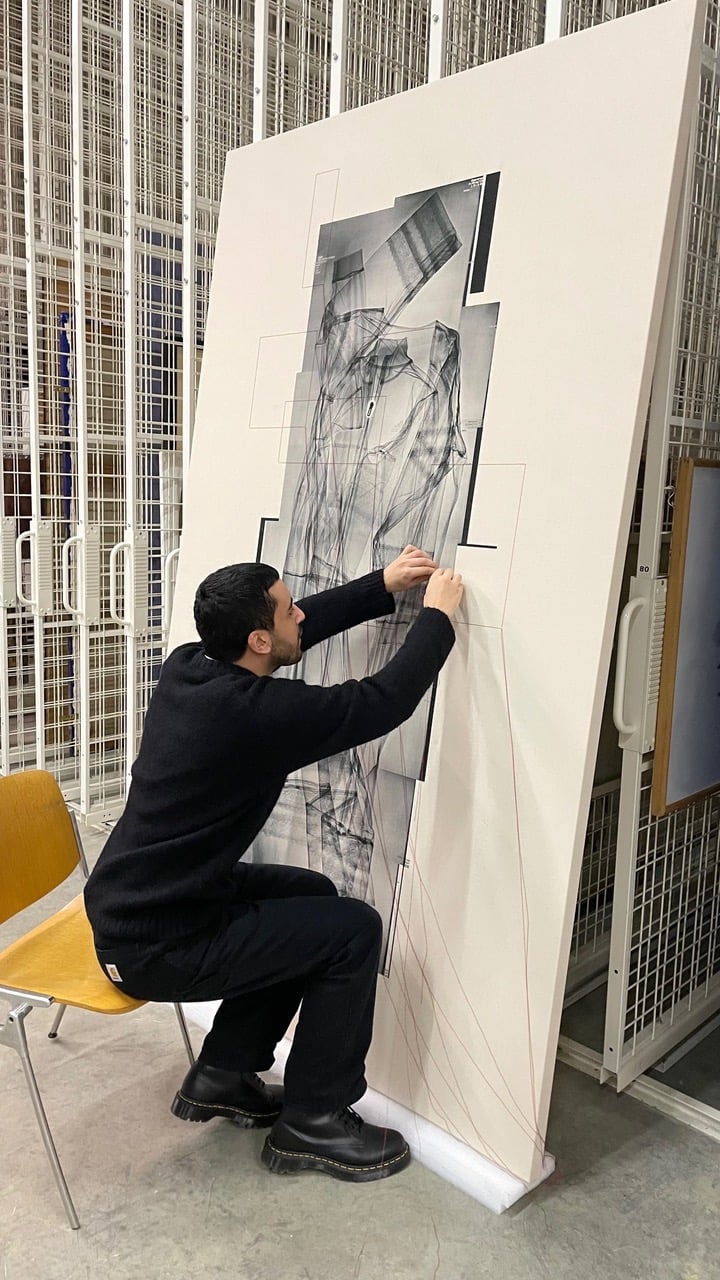
There is an otherworldly quality to the art of Tarik Kiswanson.
The artist, who was born and raised in Halmstad, a port town in Sweden where his parents immigrated from Palestine, makes paintings and sculptures that oscillate between ghostlike figuration and ephemeral abstraction. As a first-generation immigrant, Kiswanson often reflects on belonging, loss of identity, and placelessness in his work. His material of choice is handwoven steel, which fragments the viewer’s own reflection when passing by.
For his solo show “Surging,” on view at carlier | gebauer for Berlin Gallery Weekend, Kiswanson has rebuilt the gallery space into a cell-like waiting room populated by floating alien ovals and paintings of wispy evanescent forms that evoke a fading memory.
With a major project currently on view at Carré d’Art – Museum of Contemporary Art in Nîmes and upcoming solo exhibitions at Bonniers Konsthall, Stockholm, and M HKA Museum of Contemporary Art in Antwerp, the very busy artist spoke with us about how he keeps things calm at his Paris studio.
Performance view of AS DEEP AS I COULD REMEMBER, AS FAR AS I COULD SEE at Alexander Hamilton US Custom House, New York City, 2019, live performance, 55 minutes. Photo by Eian Kantor. Courtesy of the artist and Performa Biennial.
What are the most indispensable items in your studio and why?
At the moment, it’s my charcoal powder and drawing paper. But the most indispensable items constantly change as I work in different media: sculpture, film, sound. Something I always need is my computer as I write a lot.
What is the studio task on your agenda tomorrow that you are most looking forward to?
To finish a drawing I have been working on for some time. I also have a new book of poems coming out soon so looking forward to working on the layout with my publisher and the graphic designer.
What kind of atmosphere do you prefer when you work? Do you listen to music or podcasts, or do you prefer silence? Why?
Music and silence—it depends on what I am doing. A lot of my works are time consuming, so music is often essential.
Tarik Kiswanson, Mirrorbody, exhibition view at Carré d’Art Musée d’Art Contemporain, Nîmes, 2021. Photo: Vinciane Lebrun-Verguethen
What trait do you most admire in a work of art?
A sense of radicality and intention. I like vulnerability and works that are true to the artist’s own experience.
What trait do you most despise?
The lack of thought and intention. When the form feels disconnected from the discourse.
What snack food could your studio not function without?
I don’t eat snack food. I rarely eat between meals. I often forget to eat until my assistant tells me its lunchtime. It’s not intentional—I’m just very concentrated.
Who are your favorite artists, curators, or other thinkers to follow on social media right now?
I have always admired the work of Felix Gonzalez Torres. The foundation dedicated to the preservation of his legacy created an Instagram account. The content is great as they post well-known works but also bring to light less familiar ones. There are shots from past and present exhibitions of his work.
Tarik Kiswanson, “Surging,” exhibition view at carlier | gebauer, Berlin, 2021.
Photo: Trevor Good / carlier | gebauer, Berlin/Madrid.
When you feel stuck in the studio, what do you do to get un-stuck?
I don’t feel stuck in my studio. If I get tired of working on a specific work, I move on to another medium or another work. There is no rupture. I think I am always working on some subconscious level, even during the moments away from my studio.
What is the last exhibition you saw (virtual or otherwise) that made an impression on you?
I managed to see the exhibition “Drawn 1975–1993“ on the work of Leonilson at KW Institute for Contemporary Art in Berlin. It’s an impressive retrospective of the Brazilian artist who worked in a multitude of different media. The works are delicate, sensitive, and carry multiple social and political layers. I recommend it greatly.
If you had to put together a mood board, what would be on it right now?
A lot of images from the natural world that surrounds me at the moment. Birds, moths, and chrysalis—all symbols of migration and transformation.